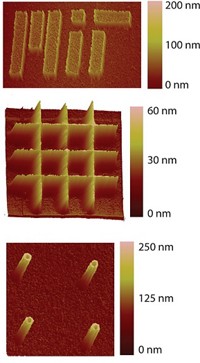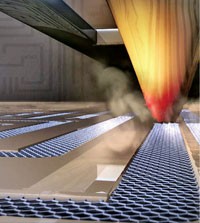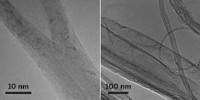Advertisement
Grab your lab coat. Let's get started
Welcome!
Welcome!
Create an account below to get 6 C&EN articles per month, receive newsletters and more - all free.
It seems this is your first time logging in online. Please enter the following information to continue.
As an ACS member you automatically get access to this site. All we need is few more details to create your reading experience.
Not you? Sign in with a different account.
Not you? Sign in with a different account.
ERROR 1
ERROR 1
ERROR 2
ERROR 2
ERROR 2
ERROR 2
ERROR 2
Password and Confirm password must match.
If you have an ACS member number, please enter it here so we can link this account to your membership. (optional)
ERROR 2
ACS values your privacy. By submitting your information, you are gaining access to C&EN and subscribing to our weekly newsletter. We use the information you provide to make your reading experience better, and we will never sell your data to third party members.
2-D Materials
Holey graphene translates to working transistor
Semiconductor material made via chemical synthesis has potential to be tunable
by Bethany Halford
April 12, 2018
| A version of this story appeared in
Volume 96, Issue 16

With the possible exception of cheese, most materials become less valuable when they’re riddled with holes. But graphene—that wondrous carbon allotrope—goes from being a semimetallic material to a semiconducting one that’s useful for a range of applications when it’s full of perforations. Scientists have now used chemical synthesis to make graphene with nanoscale holes in precise positions, and they’ve incorporated the material into a working transistor (Science 2018, DOI: 10.1126/science.aar2009).
A team led by César Moreno and Aitor Mugarza of the Catalan Institute of Nanoscience & Nanotechnology and Diego Peña of the University of Santiago de Compostela created the holey graphene starting from diphenyl–10,10'-dibromo-9,9'-bianthracene, or DP-DBBA. The researchers sublime DP-DBBA onto a gold substrate under ultrahigh vacuum, where it polymerizes at about 200 °C. Further heating to 400 °C makes the resulting polymer cyclize and dehydrogenate to form graphene nanoribbons with jagged edges.
Advertisement
The scientists originally planned to make these ribbons as their final product. “Then serendipity contributed significantly,” Peña says. Heating the gold surface just a little higher, to 450 °C, prompted the ribbons to fuse into nanoporous graphene, he explains, “graphene with atomically precise pores uniformly distributed throughout the 2-D material.”
This isn’t the first time nanoporous graphene has been prepared. Scientists have used a top-down approach, poking holes into graphene with a laser beam. But holes made this way tend to be too big, don’t have the desired precision, and don’t result in a semiconducting material. Other kinds of nanoporous graphene made via the bottom-up approach of chemical synthesis have not been reported as working in devices yet.
“In general, fabrication of electronic devices from nanoscale graphene structures is very challenging,” says Alexander Sinitskii, a chemist who studies graphene nanoribbons at the University of Nebraska, Lincoln. “But this new material can be efficiently translated into devices: Three out of every four transistors made with the nanoporous graphene work, which is pretty impressive,” he says. “I think this study will stimulate people to look more into electronic properties of these interconnected nanostructures.”
Roman Fasel, who works with graphene nanoribbons and nanoporous graphene at the Swiss Federal Laboratories for Materials Science & Technology, points out that an important aspect of the approach used to make the new nanoporous graphene is that the pores can be tuned by using different monomers. “It may thus become possible to create pores of a given diameter with specific functional groups within the pore cavities, which may result in highly selective molecular sensors or filters,” he says.
Mugarza says the group is exploring this going forward. They are also looking to use the material in other applications, including optoelectronics, water purification, DNA sequencing, and gas filtering and sensing. “We are at the moment looking for groups interested in testing our nanoporous graphene in their research,” he adds.
This article has been translated into Spanish by Divulgame.org and can be found here.





Join the conversation
Contact the reporter
Submit a Letter to the Editor for publication
Engage with us on Twitter